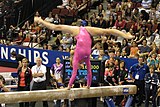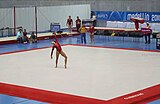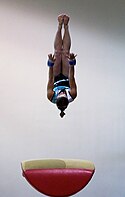Artistic gymnastics
Artistic gymnastics is a discipline of gymnastics. The Dictionary of the Spanish language defines artistic gymnastics as "Gymnastic specialty that is practiced with various devices, such as the rack or rings, or without them on a surface of regulatory measures".
Historically, as a form of physical exercise, gymnastics arose in ancient times. From the XIX century (19), artistic gymnastics became independent from general gymnastics, after the creation, in 1881, of the European Gymnastics Federation. Later, in Athens 1896, it became an Olympic sport practiced exclusively by men. As early as the 1928 Amsterdam Olympic Games, women were allowed to participate. From the middle of the XX century, this discipline began to be practiced in the way it is known today.
Performances in artistic gymnastics are generally individual and have an average duration of between thirty and ninety seconds, are performed on different apparatus, and are divided into male and female competitions. The apparatus used in the women's category are uneven bars, balance beam, floor and vault, while in the men's category they are rings, high bar, pommel horse, parallel bars, vault and floor.
The body in charge of regulating the rules of this sport, as well as organizing competitions, is the International Gymnastics Federation (FIG).
History
Modern gymnastics has its pedagogical origin in 1811, when Friedrich Ludwig Jahn, a professor at the German Institute of Berlin, created the first space for practicing artistic gymnastics in the open air. Much of today's gadgets derive from his designs.
Artistic gymnastics at the Olympic Games
From Athens 1896 to London 1948
The athletic and gymnastic part formed groups in common. The gymnastics competition was divided into an athletic part and an artistic gymnastics part. The athletic part consisted, among other tests, of a 100-meter race, high jumps and pole vaulting, rope climbing and balance exercises. In the gymnastic part, all the apparatuses were made except the floor. There was already team competition. In it you could compete in parallel and horizontal bar in a synchronized way; They are teams of eight gymnasts at most, the final score being the sum of the best six while the worst two only served in the respective individual scores. In the individual exercises competition, it was necessary to perform compulsory and optional exercises and the minimum age to perform them was 18 years. In 1928 women began to participate in this modality in the Olympic games.
Participation of women
For many years, the idea that women could compete in Olympic gymnastics was completely out of the question, even taboo for a woman to display anything other than her arms. But finally, after a long wait, the gymnasts were allowed to take part in the Games. Its first appearance was in 1928, at the Amsterdam Games, in which the Dutch team won the gold medal. Gradually, women's teams were regularly participating in gymnastics competitions.
From Helsinki 1952
This stage marks the beginning of the era of rigorously sporting gymnastics. Classical and current gymnastic events take shape, with all kinds of athletic events disappearing completely and teams made up of 6 gymnasts appearing for the first time.
Timeline of artistic gymnastics
- In 1776, the first modern gymnastics teacher was Johann Friedrich Simon, at the Basedow school in the German city of Dessau.
- In 1806 in Spain, the first official center where it was practiced was at the Instituto Real Pestalozzi, founded by Amorós in Madrid.
- In 1811, the educator Friedrich Ludwig Jahn, considered the father of gymnastics, founded in Berlin the Turnverein, the gymnastic society.
- In 1888, gymnastics was rooted in some schools and the Amateur Gymnastics Association was founded.
- In 1903 the World Championship for Men was held for the first time.
- In 1928 the female competition was added for the first time.
- In 1934 the first female World Championships were held.
- In 1975, the World Cup of Artistic Gymnastics was held for the first time.
Gymnasts
Physical characteristics
Strength, mobility, flexibility and muscle coordination, regardless of training, are critical to a gymnast's success. Genetics are crucial for these characteristics to exist and thus stand out in the chosen modality.
The preparation of a gymnast consists of three phases, with several stages:- First stage: It lasts approximately until 10 years old. The abilities of the gymnast will be "discovered through physical preparation", as well as teaching the technical foundations of sport.
- Second stage: It lasts from 10 to 15 years of age. It includes a "initial specialized preparation period", in addition to the preparation of "more complex movements and psychic characters". After a specialized training period, "the teaching of movements and combinations of greater difficulty is done".
- Third stage: It lasts from 16 to 19 years of age. At this stage the "refinance of physical preparation" will be completed, as well as the "training of elements of great difficulty".
Gadgets
Female category
Women's artistic gymnastics has four main modalities:
- Asymmetric bars
The lower bar can be adjusted between 140 and 160 cm in height, while the upper one should be between 235 and 240 cm in height. The bars are, at their base, separated by a meter of distance and can be adjusted up to a maximum separation between them of 143.5 cm. The routine varies by category.
An elite routine on the uneven bars should include transitions between the two bars, spins, different flying elements, different non-flying elements, and a final jump, which signals the end of the routine. Routines should not last more than 30 seconds.
- Balance bar
The exercise should last between 70 and 90 seconds and cover the entire length of the apparatus. The gymnast must perform acrobatic, gymnastic and dance moves to achieve a high score. There are a few demands on the balance beam: an acrobatic series that includes at least two flying elements, a one-legged spin of at least 360 degrees, a high amplitude jump, a gymnastic/acrobatic series, a gymnastic series, and a work item close to the bar. The balance beam is 1.2 m high, 10 cm wide, and 5 m long. The overall execution of the exercise must give the impression that the gymnast is performing it on the floor, not on a 1 dm wide surface. The gymnasts must perform on this apparatus a gymnastic series (gymnastic jumps), an acrobatic series (difficulty elements), a mixed series (one acrobatic element and one gymnastic), a 360 degree turn and a static element with a minimum of two seconds. duration, and finally an exit. Depending on the entrance they make to the apparatus they can use a trampoline. The exercise must be carried out without interruptions, there must be a harmonious link between the series of elements and also different rhythms. They have to be carried out along the entire length of the bar. If the gymnast falls from the bar, she has 10 s to get back up and continue with the exercise.
- Soil
The floor exercise must be musically adapted through a choreography, it must last between 70 and 90 seconds and cover the entire floor area. The gymnast must employ acrobatic, gymnastic and dance elements to get a high score on her exercise. These elements must include two acrobatic series, one with at least one or more somersaults, an acrobatic/gymnastic series, and a gymnastic series. The gymnast must harmoniously mix these elements while she must make versatile use of floor space, changing the direction and level of movement. The gymnastic elements must flow freely during the exercise while the jumps must cover great distances and the pirouettes and turns add emotion to the music. The area comprising the floor is 12 by 12 m.
- Potro salt
The jump practiced in this apparatus (horse, horse or foal) is one of those that requires a little more effort. The different jumps of this modality in the female category are grouped into four types, each one defining the various positions of the body and the movements that are carried out during the exercise. From the start of the race until the feet touch the ground, the gymnast must be totally focused. Depending on the jump that the gymnast decides to perform, it must comply with the requirements of the current code of punctuation. A good jump starts with a hard or fast run; the gymnast takes off from the springboard, raising her feet above her head with tremendous rapidity during the pre-flight (from the springboard to contact with the horse). The second flight and landing are critical phases. Note the height and distance achieved, as well as the number of somersaults and twists. In addition, gymnasts must "nail" their parking lots, without taking any extra steps. Normally, the number of somersaults and twists performed by the gymnast make up the difficulty of the vault. The track used to race towards the jump measures one meter wide by 25 m long. The foal is 120 cm tall and 35 cm wide by 160 cm long.
Male Category
Men's artistic gymnastics has six main modalities:
- Rings: the device is built by a structure where two rings hang, 2.75 m from the ground. The distance between them is 50 cm and its inner diameter is 18 cm. The test consists of a series of strength, balance and balance exercises. The jury values the control of the apparatus and the difficulty of the elements of the choreography. The less you tie the structure of which the rings hang, the better the score will be the execution of the gymnast. It is the apparatus of strength par excellence of gymnastics.
- Fixed bar: it is a 2.40 m long bar, placed parallel to the ground on a metal structure at 2.80 m high. The test consists of movements of strength and balance. The gymnast should make rotating movements in an acrobatic routine, which includes the spins proper, loose, retouching and pirouettes. One of the main features in this apparatus is the fluidity with which the routine is developed. One element must be linked to another without arrest and maintaining the continuity and direction of the initial movement. For this purpose, any unjustified interruption or change in the direction of the movement is a reason for deduction. Another definitive element to qualify, is the angle where each exercise begins or ends, taking as reference imaginary lines that mark us from 0o to 360o. At present it is about making this a very attractive device for its acrobatics, so each exercise that is performed has to be different from the next.
- Horse with bows: Thus called by its likeness with the animal, it is an apparatus composed of a loin raised on which two transversal arches are assembled. It has the following dimensions: 1.15 m height by 1.60 m length and a width of 35 cm. The height of the arches is 12 cm and the distance between both arches is adjustable between 40 cm and 45 cm. A typical series of the horse with arches is based on the movement of the legs, that the gymnast must move circularly (mouldines) taken with the hands of the rings, although it is necessary to execute also pendullar movements (scissors). Movements must run without interruption and without the legs touching the apparatus
- Parallel bars: it is two bars of 3.5 meters, placed at 1.75 m of height and in parallel form, distanced from each other by a distance of between 42 cm and 52 cm. The test consists of balancing exercises — handshakes and stops — and strength, where the gymnast must use the two bars.
- Potro salt: it is about jumping on a platform driven by a trampoline. It is the minor proof of artistic gymnastics. Each gymnast is entitled to two jumps. The track is 25 meters and ends in the trampoline in which the gymnast should take impulse to jump to a pot placed at 1.35 meters high. The jump must be made with both feet together and simultaneously support both hands on the pot, having to fall more than two meters from the pot.
- Soil: is made on a surface of 12x12 meters, built of an elastic material to cushion the falls. The exercises last 50 to 70 s, for men. During the test, acrobatic and gymnastic movements previously identified in the starting note are performed.
Rules
The way gymnastics is evaluated
Official artistic gymnastics competitions usually have three modalities in both the male and female categories:
- General individual jurisdiction
- Individual ends by appliances
- Team competition
In the all-around individual competition, each gymnast competes on all apparatus to crown the individual champion. The 24 gymnasts with the best scores in the qualifying round participate in the final. The final grade of each gymnast is obtained by adding the score she got on each apparatus.
In the individual apparatus finals, the best athlete in each of them is defined. The 8 gymnasts with the best scores in each apparatus during the qualifying round participate in this competition, allowing a maximum of two gymnasts of the same nationality.
In the team competition, the eight teams with the best scores during the qualifying round participate.
Scoring system
The scoring system is set by the FIG for all levels of competition. Lower levels or competitions outside the jurisdiction of the FIG are governed by different regulations.
The current system dates from 2006, when the current rules underwent a profound modification due to the controversies at the 2004 Athens Olympic Games, in which the objectivity of the scoring rules at the time was questioned and an excessive assessment was criticized. of the difficulty of the exercises to the detriment of their execution.
Overview of the new system
One of the main elements of the scoring system is the elements table. This table includes the possible elements (spins, jumps, acrobatics, etc) of this sport, assigning them a level of difficulty. Each of the exercises is evaluated by two groups of judges, thus obtaining two scores. Each group of judges evaluates one of the following aspects of the exercise:
- Difficulty: To obtain the value of the difficulty qualification, first the eight most difficult elements of the exercise are added according to the table of elements and their scores are added. The value obtained is added points by extra elements or by containing elements of all required groups. The realization of dangerous elements entails a criminalization of the routine.
- Implementation: Up to 10.0 points, the artistic execution of the exercise is evaluated, criminalizing, for example, the fall of the apparatus.
The sum of these two scores will be the final grade for the exercise.
Contenido relacionado
1977 Formula 1 season
Bulgarian national football team
Jose Raul Capablanca




